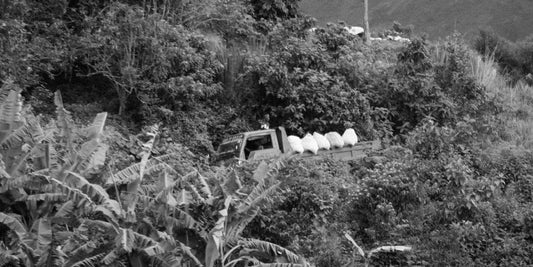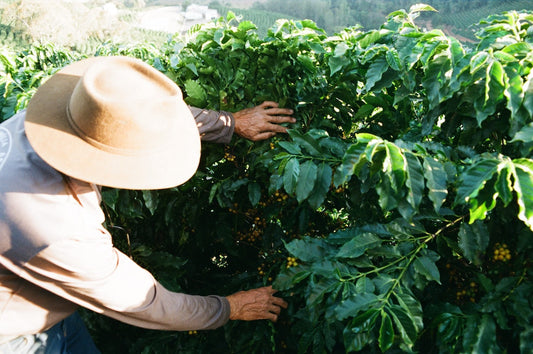
The Road to Transparent Coffee Pricing
Coffee pricing is complex – while we publish transparency information, we feel it is important to put these numbers into context and explain the wider circumstances around them. This blog is our attempt to make sense of it while also explaining why there isn’t a simple one-size-fits-all answer to the problem of farmers being underpaid. As an industry we need to get better at stripping away the noise so customers can actually see what’s going on. This is a start.
Pricing and traceability
Coffee is traded on a global commodity exchange called the “C price” in New York. This number shifts daily and sets the reference point for most contracts between buyers and sellers. The issue? It has nothing to do with the farmer’s real costs of producing coffee. It ignores the impact of localised climate fluctuations on yield, farm investment and whether a farmer earns enough to live on.
That’s why buying “above the C” doesn’t automatically mean farmers are paid fairly.
At Roastworks, we want to show not only what we paid but also whether that price actually works for the farmer. Because unless the price makes sense to producers, it’s just greenwashing.
What we could publish
Landed price
This is what the coffee costs once it arrives in the UK, including shipping, storage, finance and importer margin. It’s useful for us but tells you nothing about what the farmer received.
FOB price
FOB (Free On Board) is the export price at the point coffee is loaded onto a ship. It’s often used for comparisons but again it doesn’t show how much of that value went to the farmer. And let’s be honest – who actually knows what FOB means?
Farm gate price
This is the price paid directly to the farmer or producing group before export costs. It’s the clearest measure of what producers actually receive. It also lets us compare this number against benchmarks like cost of production or a living income. Put simply: it’s the “price paid to farmer” and everyone understands that.
Cost of production
This metric is the one we’re most excited to talk about. It’s pretty much unheard of for roasteries to publish this data, because it’s notoriously difficult and sensitive to get hold of. We’re currently working with our import/export partners to gather this information from each of the producers we work with. Knowing this data is the first step to ensuring the farmer is making a sustainable income. This allows us to put all other prices along the supply chain into context, without this metric all the others are arguably obsolete.
Why it’s not simple
Farm-gate prices can’t be looked at in isolation. Context matters.
In Brazil many farmers run large, mechanised farms with high yields, so $2.00/lb* may comfortably cover costs. In places like Peru or Mexico, where yields are lower per hectare that same price wouldn’t be enough. Or, in East Africa farmers often deliver cherry (unprocessed coffee) to a mill, which isn't purchased in $/lb, but a local currency, often at a government-set rate. Comparisons across countries means accounting for conversion factors (ie: how many kilos of cherry = one kilo of green coffee) plus exchange rates. Coffee is bought in local currency, sold internationally in USD and purchased here in GBP. So it isn't simple.
* Coffee is most commonly traded in lb/$, so this is the measure we will use when calculating % above cost of production, although we then convert the price we pay to kg/£ when we receive the coffee in the UK.
Why we avoid “% above C”
You’ll often see claims like “we paid 50% above the C price”. Sounds good – but it’s misleading.
If the C price is unusually low, even a big percentage on top may still leave the farmer short. Example: if the ‘C’ is 100c/lb and the farmer receives 150c/lb, that’s a 50% premium. But if their costs are 180c/lb, they’re still losing money.
It also compares two different points in the supply chain: the ‘C’ references a processed, shipped product while many farmers sell much earlier in the chain.
Our approach
Once the system is live, we’ll publish the price we paid to the producer(s) and compare it to their cost of production. This gives a clearer sense of whether our purchases are sustainable.
Where farm-specific cost of production data isn’t available, we’ll use reliable local averages. Our aim is that farm-gate prices hit a sustainable % above cost of production. We believe in most cases, this metric is a reliable income benchmark that enables us to compare across all contexts.
There is one origin we have already successfully compiled all the data for, which we're sharing below.
Peru, Velo De Novia 2025
- Quantity: 33,466lb (15,180kg)
- Cost of production: $1.52/lb
- Poverty line income:$1.91/lb
The above is calculated by taking average costs and dividing by average yield of a farm, using real data from the farms we work with, through our exporting partner Caravela, published in 2025.
- Farm gate (price paid to Velo De Novia producers): $3.72/lb
- Price relative to cost of production = 244%
Limits and context
Costs vary hugely depending on farm size, region and production method.
Sometimes government-set cherry prices or long forward contracts limit what we can influence. That’s why we work with exporters and importers who are transparent about farmer payments and we avoid contracts that lock in low prices before harvest.
Our commitment
Traceability isn’t just about price. For every lot we buy we know who produced it, where it was grown, which mill or exporter handled it, right through to our roastery.
Our belief is simple: traceability should be clear, easy to understand and rooted in real farm economics. By publishing farm-gate prices against cost of production benchmarks and by documenting each coffee’s journey, we hold ourselves accountable.
It won’t be perfect, but it’s a start.
If you want to dig deeper, just ask us. We’re always happy to talk about how we buy our coffee.




